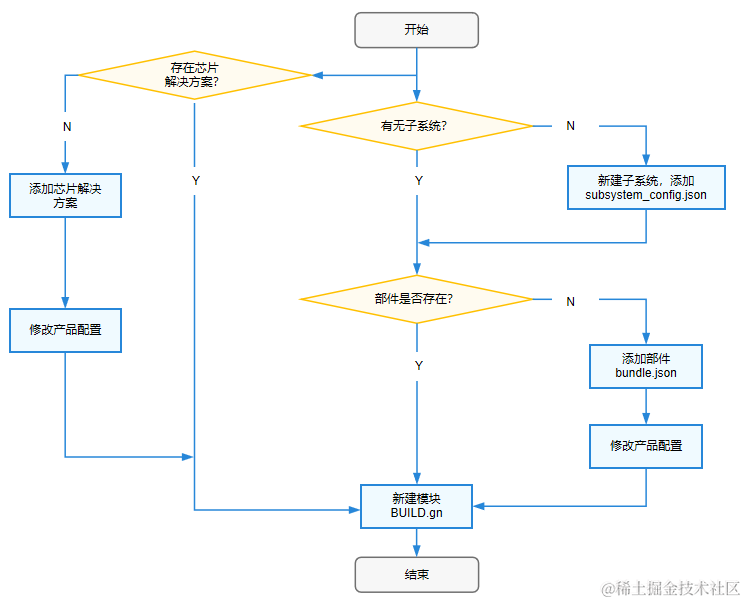

鸿蒙OpenHarmony【标准系统编写“Hello World”程序】 (基于RK3568开发板)
电子说
描述
编写“Hello World”程序
下方将展示如何在单板上运行第一个应用程序,其中包括新建应用程序、编译、烧写、运行等步骤,最终输出“Hello World!”。
前提条件
已参考[创建工程并获取源码],创建RK3568开发板的源码工程。
示例目录
拉取openharmony项目代码,在代码根目录创建sample子系统文件夹,在子系统目录下创建hello部件文件夹,hello文件夹中创建hello源码目录,构建文件BUILD.gn及部件配置文件bundle.json。 示例完整目录如下。
HarmonyOS与OpenHarmony鸿蒙文档籽料:mau123789是v直接拿
sample/hello
│── BUILD.gn
│── include
│ └── helloworld.h
│── src
│ └── helloworld.c
├── bundle.json
build
└── subsystem_config.json
vendor/hihope
└── rk3568
└── config.json
开发步骤
鸿蒙开发指导文档:[gitee.com/li-shizhen-skin/harmony-os/blob/master/README.md]

请在源码目录中通过以下步骤创建“Hello World”应用程序。
创建目录,编写业务代码。
新建sample/hello/src/helloworld.c目录及文件,代码如下所示,用户可以自定义修改打印内容(例如:修改World为OHOS)。其中helloworld.h包含字符串打印函数HelloPrint的声明。当前应用程序可支持标准C及C++的代码开发。#include < stdio.h > #include "helloworld.h" int main(int argc, char **argv) { HelloPrint(); return 0; } void HelloPrint() { printf("nn"); printf("nttHello World!n"); printf("nn"); }再添加头文件sample/hello/include/helloworld.h,代码如下所示。
#ifndef HELLOWORLD_H #define HELLOWORLD_H #ifdef __cplusplus #if __cplusplus extern "C" { #endif #endif void HelloPrint(); #ifdef __cplusplus #if __cplusplus } #endif #endif #endif // HELLOWORLD_H新建编译组织文件。
新建sample/hello/BUILD.gn,创建方法可参考:[模块配置规则]。
模块
模块配置规则
编译子系统通过模块、部件和产品三层配置来实现编译和打包。模块就是编译子系统的一个目标,包括(动态库、静态库、配置文件、预编译模块等)。模块要定义属于哪个部件,一个模块只能归属于一个部件。OpenHarmony使用定制化的Gn模板来配置模块规则,Gn语法相关的基础知识请参考[官网手册]
以下是常用的模块配置规则:
# C/C++模板
ohos_shared_library
ohos_static_library
ohos_executable
ohos_source_set
# 预编译模板:
ohos_prebuilt_executable
ohos_prebuilt_shared_library
ohos_prebuilt_static_library
#hap模板
ohos_hap
ohos_app_scope
ohos_js_assets
ohos_resources
#rust模板
ohos_rust_executable
ohos_rust_shared_library
ohos_rust_static_library
ohos_rust_proc_macro
ohos_rust_shared_ffi
ohos_rust_static_ffi
ohos_rust_cargo_crate
ohos_rust_systemtest
ohos_rust_unittest
ohos_rust_fuzztest
#其他常用模板
#配置文件
ohos_prebuilt_etc
#sa配置
ohos_sa_profile
ohos开头的模板与内建模板的差异主要在于:推荐使用ohos定制模板。
C/C++模板示例
ohos开头的模板对应的.gni文件路径在:openharmony/build/templates/cxx/cxx.gni。
ohos_shared_library示例
import("//build/ohos.gni")
ohos_shared_library("helloworld") {
sources = ["file"]
include_dirs = [] # 如有重复头文件定义,优先使用前面路径头文件。
cflags = [] # 如重复冲突定义,后面的参数优先生效,也就是该配置项中优先生效。
cflags_c = []
cflags_cc = []
ldflags = [] # 如重复冲突定义,前面参数优先生效,也就是ohos_template中预制参数优先生效。
configs = []
deps = [] # 部件内模块依赖
external_deps = [ # 跨部件模块依赖定义
"part_name:module_name", # 定义格式为 "部件名:模块名称"。
] # 这里依赖的模块必须是依赖的部件声明在inner_kits中的模块。
output_name = [string] # 模块输出名
output_extension = [] # 模块名后缀
module_install_dir = "" # 模块安装路径,缺省在/system/lib64或/system/lib下; 模块安装路径从system/,vendor/后开始指定。
relative_install_dir = "" # 模块安装相对路径,相对于/system/lib64或/system/lib;如果有module_install_dir配置时,该配置不生效。
part_name = "" # 必选,所属部件名称
output_dir
# Sanitizer配置,每项都是可选的,默认为false/空。
sanitize = {
# 各个Sanitizer开关
cfi = [boolean] # 控制流完整性检测
cfi_cross_dso = [boolean] # 开启跨so调用的控制流完整性检测
integer_overflow = [boolean] # 整数溢出检测
boundary_sanitize = [boolean] # 边界检测
ubsan = [boolean] # 部分ubsan选项
all_ubsan = [boolean] # 全量ubsan选项
...
debug = [boolean] # 调测模式
blocklist = [string] # 屏蔽名单路径
}
testonly = [boolean]
license_as_sources = []
license_file = [] # 后缀名是.txt的文件
remove_configs = []
no_default_deps = []
install_images = []
install_enable = [boolean]
symlink_target_name = []
version_script = []
use_exceptions = []
}
ohos_static_library示例
import("//build/ohos.gni")
ohos_static_library("helloworld") {
sources = ["file"] # 后缀名是.c的相关文件
include_dirs = ["dir"] # 包含目录
configs = [] # 配置
deps = [] # 部件内模块依赖
part_name = "" # 部件名称
subsystem_name = "" # 子系统名称
cflags = []
external_deps = [ # 跨部件模块依赖定义,
"part_name:module_name", # 定义格式为 "部件名:模块名称"
] # 这里依赖的模块必须是依赖的部件声明在inner_kits中的模块。
lib_dirs = []
public_configs = []
# Sanitizer配置,每项都是可选的,默认为false/空
sanitize = {
# 各个Sanitizer开关
cfi = [boolean] # 控制流完整性检测
cfi_cross_dso = [boolean] # 开启跨so调用的控制流完整性检测
integer_overflow = [boolean] # 整数溢出检测
boundary_sanitize = [boolean] # 边界检测
ubsan = [boolean] # 部分ubsan选项
all_ubsan = [boolean] # 全量ubsan选项
...
debug = [boolean] # 调测模式
blocklist = [string] # 屏蔽名单路径
}
remove_configs = []
no_default_deps = []
license_file = [] # 后缀名是.txt的文件
license_as_sources = []
use_exceptions = []
}
ohos_executable示例
import("//build/ohos.gni")
ohos_executable("helloworld") {
configs = [] # 配置
part_name = "" # 部件名称
subsystem_name = "" # 子系统名称
deps = [] # 部件内模块依赖
external_deps = [ # 跨部件模块依赖定义,
"part_name:module_name", # 定义格式为 "部件名:模块名称"
] # 这里依赖的模块必须是依赖的部件声明在inner_kits中的模块。
ohos_test = []
test_output_dir = []
# Sanitizer配置,每项都是可选的,默认为false/空
sanitize = {
# 各个Sanitizer开关
cfi = [boolean] # 控制流完整性检测
cfi_cross_dso = [boolean] # 开启跨so调用的控制流完整性检测
integer_overflow = [boolean] # 整数溢出检测
boundary_sanitize = [boolean] # 边界检测
ubsan = [boolean] # 部分ubsan选项
all_ubsan = [boolean] # 全量ubsan选项
...
debug = [boolean] # 调测模式
blocklist = [string] # 屏蔽名单路径
}
testonly = [boolean]
license_as_sources = []
license_file = [] # 后缀名是.txt的文件
remove_configs = []
static_link = []
install_images = []
module_install_dir = "" # 模块安装路径,从system/,vendor/后开始指定
relative_install_dir = ""
symlink_target_name = []
output_dir = [directory] # 存放输出文件的目录
install_enable = [boolean]
version_script = []
use_exceptions = []
}
ohos_source_set示例
import("//build/ohos.gni")
ohos_source_set("helloworld") {
sources = ["file"] # 后缀名是.c的相关文件
include_dirs = [] # 包含目录
configs = [] # 配置
public = [] # .h类型头文件
defines = []
public_configs = []
part_name = "" # 部件名称
subsystem_name = "" # 子系统名称
deps = [] # 部件内模块依赖
external_deps = [ # 跨部件模块依赖定义,
"part_name:module_name", # 定义格式为 "部件名:模块名称"
] # 这里依赖的模块必须是依赖的部件声明在inner_kits中的模块
# Sanitizer配置,每项都是可选的,默认为false/空
sanitize = {
# 各个Sanitizer开关
cfi = [boolean] # 控制流完整性检测
cfi_cross_dso = [boolean] # 开启跨so调用的控制流完整性检测
integer_overflow = [boolean] # 整数溢出检测
boundary_sanitize = [boolean] # 边界检测
ubsan = [boolean] # 部分ubsan选项
all_ubsan = [boolean] # 全量ubsan选项
...
debug = [boolean] # 调测模式
blocklist = [string] # 屏蔽名单路径
}
testonly = [boolean]
license_as_sources = []
license_file = []
remove_configs = []
no_default_deps = []
license_file = [] # 后缀名是.txt的文件
license_as_sources = []
use_exceptions = []
}
注意 :
- 只有sources和part_name是必选,其他都是可选的;
- Sanitizer配置详见:[Sanitizer使用说明]
预编译模板示例
预编译模板的.gni相关文件路径在:openharmony/build/templates/cxx/prebuilt.gni。
ohos_prebuilt_executable示例
import("//build/ohos.gni")
ohos_prebuilt_executable("helloworld") {
source = "file" # 源
output = []
install_enable = [boolean]
deps = [] # 部件内模块依赖
public_configs = []
subsystem_name = "" # 子系统名
part_name = "" # 部件名
testonly = [boolean]
visibility = []
install_images = []
module_install_dir = "" # 模块安装路径,从system/,vendor/后开始指定
relative_install_dir = "" # 模块安装相对路径,相对于system/etc;如果有module_install_dir配置时,该配置不生效。
symlink_target_name = []
license_file = [] # 后缀名是.txt的文件
license_as_sources = []
}
ohos_prebuilt_shared_library示例
import("//build/ohos.gni")
ohos_prebuilt_shared_library("helloworld") {
source = "file" # 一般是后缀为.so的文件
output = []
install_enable = [boolean]
deps = [] # 部件内模块依赖
public_configs = []
subsystem_name = "" # 子系统名
part_name = "" # 部件名
testonly = [boolean]
visibility = []
install_images = []
module_install_dir = "" # 模块安装路径,从system/,vendor/后开始指定
relative_install_dir = "" # 模块安装相对路径,相对于system/etc;如果有module_install_dir配置时,该配置不生效。
symlink_target_name = [string]
license_file = [string] # 后缀名是.txt的文件
license_as_sources = []
}
ohos_prebuilt_static_library示例
import("//build/ohos.gni")
ohos_prebuilt_static_library("helloworld") {
source = "file" # 一般是后缀为.so的文件
output = []
deps = [] # 部件内模块依赖
public_configs = []
subsystem_name = "" # 子系统名
part_name = "" # 部件名
testonly = [boolean]
visibility = []
license_file = [string] # 后缀名是.txt的文件
license_as_sources = []
}
注意 :只有sources和part_name是必选,其他都是可选的。
Hap模板
hap模板详见:[ HAP编译构建指导]
Rust模板
rust模板详见:[ Rust模块配置规则和指导]
其他常用模板
ohos_prebuilt_etc示例:
import("//build/ohos.gni")
ohos_prebuilt_etc("helloworld") {
# ohos_prebuilt_etc模板最常用属性:
source = "file" # 指定单个原文件
module_install_dir = "" # 模块安装路径,从system/,vendor/后开始指定
subsystem_name = "" # 子系统名
part_name = "" # 必选,所属部件名称
install_images = []
relative_install_dir = "" # 模块安装相对路径,相对于system/etc;如果有module_install_dir配置时,该配置不生效。
# ohos_prebuilt_etc模板不常用属性:
deps = [] # 部件内模块依赖
testonly = [boolean]
visibility = []
public_configs = []
symlink_target_name = [string]
license_file = [string]
license_as_sources = []
}
ohos_sa_profile示例:
import("//build/ohos.gni")
ohos_sa_profile("helloworld") {
sources = [".xml"] # xml文件
part_name = "" # 部件名
subsystem_name = "" # 子系统名
}
注意 :只有sources和part_name是必选,其他都是可选的。
新增并编译模块
新建模块可以分为以下三种情况。主要的添加逻辑如下面的流程图所示,若没有子系统则需新建子系统并在该子系统的部件下添加模块,若没有部件则需新建部件并在其中添加模块,否则直接在原有部件中添加模块即可,需要注意的是芯片解决方案作为特殊部件是没有对应子系统的。
- 在原有部件中添加一个模块
- 新建部件并在其中添加模块
- 新建子系统并在该子系统的部件下添加模块

在原有部件中添加一个模块
- 在模块目录下配置BUILD.gn,根据模板类型选择对应的gn模板。
- 修改bundle.json配置文件。
{ "name": "@ohos/< component_name >", # HPM部件英文名称,格式"@组织/部件名称" "description": "xxxxxxxxxxxxxxxxxxx", # 部件功能一句话描述 "version": "3.1", # 版本号,版本号与OpenHarmony版本号一致 "license": "MIT", # 部件License "publishAs": "code-segment", # HPM包的发布方式,当前默认都为code-segment "segment": { "destPath": "third_party/nghttp2" }, # 发布类型为code-segment时为必填项,定义发布类型code-segment的代码还原路径(源码路径)。 "dirs": {}, # HPM包的目录结构,字段必填内容可以留空 "scripts": {}, # HPM包定义需要执行的脚本,字段必填,值非必填 "licensePath": "COPYING", "readmePath": { "en": "README.rst" }, "component": { # 部件属性 "name": "< component_name >", # 部件名称 "subsystem": , # 部件所属子系统 "syscap": [], # 部件为应用提供的系统能力 "features": [], # 部件对外的可配置特性列表,一般与build中的sub_component对应,可供产品配置。 "adapted_system_type": [], # 轻量(mini)小型(small)和标准(standard),可以是多个 "rom": "xxxKB" # ROM基线,没有基线写当前值 "ram": "xxxKB", # RAM基线,没有基线写当前值 "deps": { "components": [], # 部件依赖的其他部件 "third_party": [] # 部件依赖的三方开源软件 }, "build": { # 编译相关配置 "sub_component": [ "//foundation/arkui/napi:napi_packages", # 原有模块1 "//foundation/arkui/napi:napi_packages_ndk" # 原有模块2 "//foundation/arkui/napi:new" # 新增模块new ], # 部件编译入口,模块在此处配置 "inner_kits": [], # 部件间接口 "test": [] # 部件测试用例编译入口 } } }
注意 :无论哪种方式该bundle.json文件均在对应子系统所在文件夹下。
- 成功添加验证:编译完成后打包到image中去,生成对应的so文件或者二进制文件。
新建部件并在其中添加一个模块
- 在模块目录下配置BUILD.gn,根据模板类型选择对应的gn模板。这一步与在原有部件中添加一个模块的方法基本一致,只需注意该模块对应BUILD.gn文件中的part_name为新建部件的名称即可。
- 新建一个bundle.json文件,bundle.json文件均在对应子系统所在文件夹下。
- 在vendor/{product_company}/{product-name}/config.json中添加对应的部件,直接添加到原有部件后即可。
"subsystems": [ { "subsystem": "部件所属子系统名", "components": [ { "component": "部件名1", "features":[] }, # 子系统下的原有部件1 { "component": "部件名2", "features":[] }, # 子系统下的原有部件2 { "component": "部件名new", "features":[] } # 子系统下的新增部件new ] }, . ] - 成功添加验证:编译完成后打包到image中去,生成对应的so文件或者二进制文件。
新建子系统并在该子系统的部件下添加模块
在模块目录下配置BUILD.gn,根据模板类型选择对应的gn模板。这一步与新建部件并在其中添加模块中对应的步骤并无区别。
在新建的子系统目录下每个部件对应的文件夹下创建bundle.json文件,定义部件信息。这一步与新建部件并在其中添加模块中对应的步骤并无区别。
修改build目录下的subsystem_config.json文件。
{ "子系统名1": { # 原有子系统1 "path": "子系统目录1", "name": "子系统名1" }, "子系统名2": { # 原有子系统2 "path": "子系统目录2", "name": "子系统名2" }, "子系统名new": { # 新增子系统new "path": "子系统目录new", "name": "子系统名new" }, }该文件定义了有哪些子系统以及这些子系统所在文件夹路径,添加子系统时需要说明子系统path与name,分别表示子系统路径和子系统名。
在vendor/{product_company}/{product-name}目录下的产品配置如product-name是hispark_taurus_standard时,在config.json中添加对应的部件,直接添加到原有部件后即可。
"subsystems": [ { "subsystem": "arkui", # 原有的子系统名 "components": [ # 单个子系统下的所有部件集合 { "component": "ace_engine_standard", # 原有的部件名 "features": [] }, { "component": "napi", # 原有的部件名 "features": [] } { "component": "component_new1", # 原有子系统新增的的部件名component_new1 "features": [] } ] }, { "subsystem": "subsystem_new", # 新增的子系统名 "components": [ { "component": "component_new2", # 新增子系统新增的的部件名component_new2 "features": [] } ] }, ]成功添加验证:编译完成后打包到image中去,生成对应的so文件或者二进制文件。
编译模块
主要有两种编译方式,[命令行方式和hb方式],这里以命令行方式为例。
模块可以使用“--build-target 模块名"单独编译,编译命令如下:
./build.sh --build-target 模块名
也可以编译相应产品,以编译hispark_taurus_standard为例,编译命令如下:
./build.sh --product-name hispark_taurus_standard --build-target 模块名 --ccache
还可以编译模块所在的部件:
./build.sh --product-name hispark_taurus_standard --build-target musl --build-target 模块名 --ccache
创建 BUILD.gn内容如下所示:
import("//build/ohos.gni") # 导入编译模板
ohos_executable("helloworld") { # 可执行模块
sources = [ # 模块源码
"src/helloworld.c"
]
include_dirs = [ # 模块依赖头文件目录
"include"
]
cflags = []
cflags_c = []
cflags_cc = []
ldflags = []
configs = []
deps =[] # 部件内部依赖
part_name = "hello" # 所属部件名称,必选
install_enable = true # 是否默认安装(缺省默认不安装),可选
}
- 新建部件配置规则文件
新建sample/hello/bundle.json文件,添加sample部件描述,创建方法可参考:[部件配置规则]
部件配置规则
部件的bundle.json放在部件源码的根目录下。以泛sensor子系统的sensor服务部件为例,部件属性定义描述文件字段说明如下:
{
"name": "@ohos/sensor_lite", # HPM部件英文名称,格式"@组织/部件名称"
"description": "Sensor services", # 部件功能一句话描述
"version": "3.1", # 版本号,版本号与OpenHarmony版本号一致
"license": "MIT", # 部件License
"publishAs": "code-segment", # HPM包的发布方式,当前默认都为code-segment
"segment": {
"destPath": ""
}, # 发布类型为code-segment时为必填项,定义发布类型code-segment的代码还原路径(源码路径)
"dirs": {"base/sensors/sensor_lite"}, # HPM包的目录结构,字段必填内容可以留空
"scripts": {}, # HPM包定义需要执行的脚本,字段必填,值非必填
"licensePath": "COPYING",
"readmePath": {
"en": "README.rst"
},
"component": { # 部件属性
"name": "sensor_lite", # 部件名称
"subsystem": "", # 部件所属子系统
"syscap": [], # 部件为应用提供的系统能力
"features": [], # 部件对外的可配置特性列表,一般与build中的sub_component对应,可供产品配置
"adapted_system_type": [], # 轻量(mini)小型(small)和标准(standard),可以是多个
"rom": "92KB", # 部件ROM值
"ram": "~200KB", # 部件RAM估值
"deps": {
"components": [ # 部件依赖的其他部件
"samgr_lite",
"ipc_lite"
],
"third_party": [ # 部件依赖的三方开源软件
"bounds_checking_function"
],
"hisysevent_config": [] # 部件HiSysEvent打点配置文件编译入口
}
"build": { # 编译相关配置
"sub_component": [
""//base/sensors/sensor_lite/services:sensor_service"", # 部件编译入口
], # 部件编译入口,模块在此处配置
"inner_kits": [], # 部件间接口
"test": [] # 部件测试用例编译入口
}
}
}
注意 :lite上旧的部件在build/lite/components目录下对应子系统的json文件中,路径规则为: {领域}/{子系统}/{部件} ,部件目录树规则如下:
component
├── interfaces
│ ├── innerkits # 系统内接口,部件间使用
│ └── kits # 应用接口,应用开发者使用
├── frameworks # framework实现
├── services # service实现
└── BUILD.gn # 部件编译脚本
部件配置中需要配置部件的名称、源码路径、功能简介、是否必选、编译目标、RAM、ROM、编译输出、已适配的内核、可配置的特性和依赖等属性定义。
注意 :部件配置中HiSysEvent打点配置文件使用说明,请参考文档[HiSysEvent打点配置]。
新增部件时需要在对应子系统json文件中添加相应的部件定义。产品所配置的部件必须在某个子系统中被定义过,否则会校验失败。
新增并编译部件
添加部件。 本节以添加一个自定义的部件为例,描述如何编译部件,编译库、编译可执行文件等。
示例部件partA由feature1、feature2和feature3组成,feature1的编译目标为一个动态库,feature2的目标为一个可执行程序,feature3的目标为一个etc配置文件。
示例部件partA的配置需要添加到一个子系统中,本次示例将添加到subsystem_examples子系统中(subsystem_examples子系统定义在test/examples/目录)。
示例部件partA的完整目录结构如下:test/examples/partA ├── feature1 │ ├── BUILD.gn │ ├── include │ │ └── helloworld1.h │ └── src │ └── helloworld1.cpp ├── feature2 │ ├── BUILD.gn │ ├── include │ │ └── helloworld2.h │ └── src │ └── helloworld2.cpp └── feature3 ├── BUILD.gn └── src └── config.conf示例1:编写动态库gn脚本test/examples/partA/feature1/BUILD.gn,示例如下:
config("helloworld_lib_config") { include_dirs = [ "include" ] } ohos_shared_library("helloworld_lib") { sources = [ "include/helloworld1.h", "src/helloworld1.cpp", ] public_configs = [ ":helloworld_lib_config" ] part_name = "partA" }示例2:编写可执行文件gn脚本test/examples/partA/feature2/BUILD.gn,示例如下:
ohos_executable("helloworld_bin") { sources = [ "src/helloworld2.cpp" ] include_dirs = [ "include" ] deps = [ # 依赖部件内模块 "../feature1:helloworld_lib" ] external_deps = [ "partB:module1" ] # (可选)如果有跨部件的依赖,格式为“部件名:模块名” install_enable = true # 可执行程序缺省不安装,需要安装时需要指定 part_name = "partA" }示例3:编写etc模块gn脚本test/examples/partA/feature3/BUILD.gn,示例如下:
ohos_prebuilt_etc("feature3_etc") { source = "src/config.conf" relative_install_dir = "init" #可选,模块安装相对路径,相对于默认安装路径;默认在/system/etc目录 part_name = "partA" }示例4:在部件的bundle.json中添加模块配置:test/examples/bundle.json。每个部件都有一个bundle.json配置文件,在部件的根目录下。示例见:[部件的bundle.json]
将部件添加到产品配置中。 在产品的配置中添加部件,产品对应的配置文件://vendor/{product_company}/{product-name}/config.json。下面以vendor/hisilicon/hispark_taurus_standard/config.json为例:
{ "product_name": "hispark_taurus_standard", "device_company": "hisilicon", "device_build_path": "device/board/hisilicon/hispark_taurus/linux", "target_cpu": "arm", "type": "standard", "version": "3.0", "board": "hispark_taurus", "inherit": [ "productdefine/common/base/standard_system.json", "productdefine/common/inherit/ipcamera.json" ], "enable_ramdisk": true, "subsystems": [ { "subsystem": "subsystem_examples", # 部件所属子系统 "components": [ { "component": "partA", # 部件名称 "features": [] # 部件对外的可配置特性列表 } ] }, ······ }从中可以看出产品名称、芯片厂家等;inherit指出依赖的通用组件;subsystems指出通用组件以外的部件。
在产品配置文件中添加 "subsystem_examples:partA",表示该产品中会编译并打包partA到版本中。
编译。 主要有两种编译方式,[命令行方式和hb方式],下面以命令行方式为例:
部件可以使用"--build-target 部件名"进行单独编译,以编译产品hispark_taurus_standard的musl部件为例,编译命令如下:./build.sh --product-name hispark_taurus_standard --build-target musl --ccache也可以编译相应产品,以编译hispark_taurus_standard为例,编译命令如下:
./build.sh --product-name hispark_taurus_standard --ccache编译输出。 编译所生成的文件都归档在out/hispark_taurus/目录下,结果镜像输出在 out/hispark_taurus/packages/phone/images/ 目录下。
bundle.json内容如下所示。{ "name": "@ohos/hello", "description": "Hello world example.", "version": "3.1", "license": "Apache License 2.0", "publishAs": "code-segment", "segment": { "destPath": "sample/hello" }, "dirs": {}, "scripts": {}, "component": { "name": "hello", "subsystem": "sample", "syscap": [], "features": [], "adapted_system_type": [ "mini", "small", "standard" ], "rom": "10KB", "ram": "10KB", "deps": { "components": [], "third_party": [] }, "build": { "sub_component": [ "//sample/hello:helloworld" ], "inner_kits": [], "test": [] } } }bundle.json文件包含两个部分,第一部分描述该部件所属子系统的信息,第二部分component则定义该部件构建相关配置。添加的时候需要指明该部件包含的模块sub_component,假如有提供给其它部件的接口,需要在inner_kits中说明,假如有测试用例,需要在test中说明,inner_kits与test没有也可以不添加。
修改子系统配置文件。
在build/subsystem_config.json中添加新建的子系统的配置。修改方法可参考:[子系统配置规则]
子系统配置规则
通过build仓下的subsystem_config.json可以查看所有子系统的配置规则。
{
"arkui": {
"path": "foundation/arkui", # 路径
"name": "arkui" # 子系统名
},
"ai": {
"path": "foundation/ai",
"name": "ai"
},
"account": {
"path": "base/account",
"name": "account"
},
"distributeddatamgr": {
"path": "foundation/distributeddatamgr",
"name": "distributeddatamgr"
},
"security": {
"path": "base/security",
"name": "security"
},
...
}
子系统的配置规则主要是在build/subsystem_config.json中指定子系统的路径和子系统名称。
新增子系统的配置如下所示。
"sample": {
"path": "sample",
"name": "sample"
},
修改产品配置文件。
说明: OpenHarmony-v3.2-Beta2之前版本,RK3568的产品配置文件为productdefine/common/products/rk3568.json;从OpenHarmony-v3.2-Beta2版本开始,RK3568的产品配置文件为vendor/hihope/rk3568/config.json。
- 3.2-Beta2之前版本
在productdefine/common/products/rk3568.json中添加对应的hello部件,直接添加到原有部件后即可。"usb:usb_manager_native":{}, "applications:prebuilt_hap":{}, "sample:hello":{}, "wpa_supplicant-2.9:wpa_supplicant-2.9":{}, - 3.2-Beta2及之后版本
在vendor/hihope/rk3568/config.json中添加对应的hello部件,直接添加到原有部件后即可。{ "subsystem": "sample", "components": [ { "component": "hello", "features": [] } ] },
- 3.2-Beta2之前版本
审核编辑 黄宇
- 相关推荐
- 热点推荐
- 开发板
- 鸿蒙
- HarmonyOS
- OpenHarmony
-
鸿蒙OpenHarmony【标准系统编译】 (基于RK3568开发板)2024-04-24 2384
-
鸿蒙OpenHarmony【标准系统 编写“Hello World”程序】(基于RK3568开发板)2024-05-09 1564
-
北京迅为RK3568开发板OpenHarmony系统南向驱动开发内核HDF驱动框架架构2025-03-11 1602
-
鸿蒙OpenHarmony南向/北向快速开发教程-迅为RK3568开发板2024-07-23 2330
-
迅为RK3568开发板鸿蒙OpenHarmony系统固件烧写步骤2022-08-26 6913
-
如何在RK3568开发板上面运行OpenHarmony标准系统2022-08-31 2721
-
标准系统:KHDVK-3568A智慧屏开发套件(RK3568)2023-10-19 1121
-
RK3568开发板上丝滑体验OpenHarmony标准系统2021-12-31 4268
-
迅为RK3568开发板系统编程手册全新升级2023-06-25 1920
-
OpenHarmony:全流程讲解如何编写ADC平台驱动以及应用程序2023-09-04 2185
-
OpenHarmony:如何使用HDF平台驱动控制PWM2023-09-14 1885
-
OpenHarmony:全流程讲解如何编写RTC平台驱动以及应用程序2023-09-19 1807
-
瑞芯微RK3568鸿蒙开发板OpenHarmony系统修改cfg文件权限方法2024-09-11 2583
-
基于ArkTS语言的OpenHarmony APP应用开发:HelloOpenharmony2024-09-15 1208
-
【北京迅为】iTOP-RK3568开发板鸿蒙OpenHarmony系统南向驱动开发实操-HDF驱动配置UART2025-03-25 1354
全部0条评论

快来发表一下你的评论吧 !


